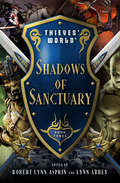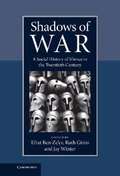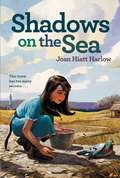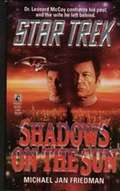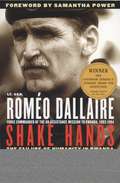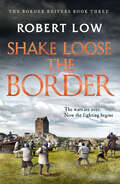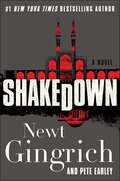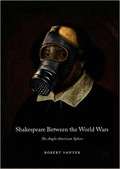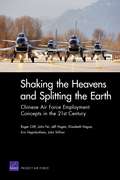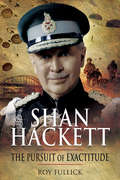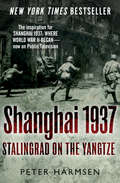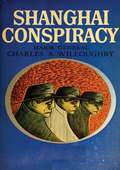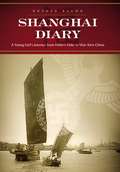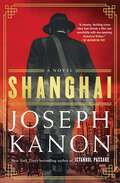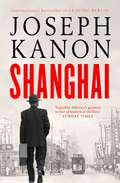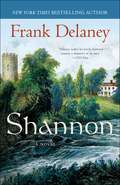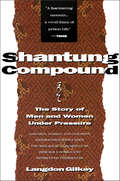- Table View
- List View
Shadows of Sanctuary: Thieves' World, Tales From The Vulgar Unicorn, And Shadows Of Sanctuary (Thieves' World® #3)
by John Brunner Joe Haldeman Philip José FarmerThe third Thieves&’ World® anthology—with stories by fantasy&’s favorite authors—curated by the New York Times–bestselling author of the Myth series. Times are hard, and the citizens of Sanctuary are not their greedy, immoral, grifting selves. But desperate times call for desperate measures, which means the bad guys are about to up their game. No one is safe from Sanctuary&’s evil charms—not the fish in the waters, not the prince&’s own Hell Hound guards, not even Satan himself.&“Shadows also includes another story by Offutt that reinforces my opinion that he is incapable of writing a bad story for this series. A number of the tales are Tempus stories, with several of our other recurring characters also making appearances. By virtue of Tempus&’ unique relationship with the god Vashanka, these stories also bring us back toward the storyline of the competing deities, and help us to look forward to new developments in the fourth book. All in all, Shadows is the strongest book amongst the first three publications.&” —Fantasy-Faction
Shadows of War: A Social History of Silence in the Twentieth Century
by Efrat Ben-Ze'Ev Ruth Ginio Jay WinterSilence lies between forgetting and remembering. This book explores how different societies have constructed silences to enable men and women to survive and make sense of the catastrophic consequences of armed conflict. Using a range of disciplinary approaches, it examines the silences that have followed violence in twentieth-century Europe, the Middle East, and Africa. These essays show that silence is a powerful language of remembrance and commemoration and a cultural practice with its own rules. This broad-ranging book discloses the universality of silence in the ways we think about war through examples ranging from the Spanish Civil War and the Israeli-Palestinian conflict to the Armenian Genocide and South Africa's Truth and Reconciliation Commission. Bringing together scholarship on varied practices in different cultures, this book breaks new ground in the vast literature on memory, and opens up new avenues of reflection and research on the lingering aftermath of war.
Shadows on the Sea
by Joan Hiatt Harlow1942. The U.S. is at war with Germany. Fourteen-year-old Jill Winter's mother is traveling to Newfoundland and must pass through the treacherous North Atlantic, where German submarines -- U-boats -- stalk like wolves. Jill's father, a famous pop singer, is on tour, so Jill is sent to Winter Haven, Maine, to stay with Nana. Quarry, a local boy, says that "gossip ain't never been so good," and Jill soon discovers he's right -- Winter Haven is full of secrets and rumors. It seems everyone has something to hide -- even Nana! Jill doesn't know whom to trust, and she's worried for her mother's safety. And things get even worse when she finds a wounded carrier pigeon with a coded message attached to its leg. Jill is determined to get to the bottom of all these mysteries, but when she uncovers the biggest secret of all, she finds herself in grave danger -- and must run for her life!
Shadows on the Sun (Star Trek: The Original Series)
by Michael Jan FriedmanAs a young doctor with a beautiful family and a promising medical career, Dr. Leonard McCoy thought he had it all. But when the woman he loved betrayed him, McCoy fled to Starfleet, hoping to lose his pain in the depths of space. Now, more than forty years later, the EnterpriseTM and her crew are ordered to transport a group of mediators to the planet Ssan, a world where assassination is a time-honored tradition, and McCoy is surprised to learn that his ex-wife, now remarried, is one of the mediators. And before he can come to terms with his conflicted feelings for his former love, she and Captain Kirk are trapped on Susan, and McCoy is caught in an explosive civil war, the only one with the power to save the woman who once nearly destroyed him.
Shadows on the Track: Australia's Medical War in Papua 1942-1943Kokoda - Milne Bay - The Beachhead Battles
by Jan McLeodAt Templeton&’s Crossing in October 1942, Private Nick Kennedy paused to write in his diary: &‘One wonders why all this strife should be … these men in the prime of their life cut down like flowers&’. As a young nursing orderly serving with the 2/4th Australian Field Ambulance, Kennedy was unenviably well-placed to reflect on the futility of war. The Australian Army was woefully unprepared to fight a medical war in Papua and the soldiers paid the price. Almost 30,000 soldiers suffered from illness and tropical diseases, and an estimated 6000 were killed or wounded during the six-month campaign. These statistics have traditionally been represented as unavoidable consequences of fighting a war in a place such as Papua. This book disputes that narrative. Death and disease were inevitable outcomes, but the scale of the suffering was not. The medical challenges presented in Papua were extreme – they were not insurmountable. Shadows on the Track considers a wide range of issues that impacted on the health of the Australian soldiers before, during and after the Papuan campaign was fought and won. The strengths, successes, shortcomings and failures of the medical campaign are identified, analysed and evaluated. The focus on the front-line medical personnel – the men of the field ambulance units – brings a new perspective to the battles of the Kokoda Track, Milne Bay and the Beachheads. Shining a light on these Australians who tended the sick, mended the wounded and buried the dead in Papua makes stepping out of the shadows a little easier.
Shadows over Stonewycke (Stonewycke Legacy #2)
by Judith Pella Michael R. PhillipsBook 2 of The Stonewycke Legacy is set shortly before the outbreak of World War II. Espionage and intrigue, tragedy, and restoration.
Shadowstory
by Jennifer JohnstonA compelling novel of complicated love, from one of Ireland's greatest living writers. It is the Second World War, and tragedy strikes many families in Ireland. But it is also a thrilling time in which to be a child and Polly, spending months at her grandparents' house by the sea, barely notices the adults' grief and their efforts to escape the tyranny of religion and family expectation. However, in time Polly too will have a secret. No one else knows the location of her beloved uncle, Sam, barely older than Polly herself, who is meant to be in Cambridge but is dreaming of Communist Cuba, while his decimated family fears losing another son. And, as Polly shyly approaches womanhood, her love for Sam turns into something more explosive.
Shadowstory
by Jennifer JohnstonA compelling novel of complicated love, from one of Ireland's greatest living writers. It is the Second World War, and tragedy strikes many families in Ireland. But it is also a thrilling time in which to be a child and Polly, spending months at her grandparents' house by the sea, barely notices the adults' grief and their efforts to escape the tyranny of religion and family expectation. However, in time Polly too will have a secret. No one else knows the location of her beloved uncle, Sam, barely older than Polly herself, who is meant to be in Cambridge but is dreaming of Communist Cuba, while his decimated family fears losing another son. And, as Polly shyly approaches womanhood, her love for Sam turns into something more explosive.
Shaka the Great
by Walton Golightly1826: Shaka, king of the Zulus, has consolidated his power and is ready to move against those who continue to resist his authority. But now a new tribe has appeared, and white men from across the Great Water, claiming they wish to trade with Shaka. These white men may seem puny, and their ways strange, but Shaka believes there's more to them than meets the eye. Obsessed with divining their secrets, however, he becomes oblivious to the threat growing from within his own court.Seething with sorcery and betrayal, battles and intrigue, triumph and tragedy, Shaka the Great sees one of the greatest leaders of all time consolidate his power as the first Europeans begin to arrive on the African continent. It takes us to an empire at its zenith, in a time when the name Zulu began to echo around the world as a byword for courage and nobility.
Shake Hands with the Devil: The Failure of Humanity in Rwanda
by Romeo Dallaire LGenFor the first time in the United States comes the tragic and profoundly important story of the legendary Canadian general who "watched as the devil took control of paradise on earth and fed on the blood of the people we were supposed to protect." When Roméo Dallaire was called on to serve as force commander of the UN Assistance Mission for Rwanda, he believed that his assignment was to help two warring parties achieve the peace they both wanted. Instead, he was exposed to the most barbarous and chaotic display of civil war and genocide in the past decade, observing in just one hundred days the killings of more than eight hundred thousand Rwandans. With only a few troops, his own ingenuity and courage to direct his efforts, Dallaire rescued thousands, but his call for more support from the world body fell on deaf ears. In Shake Hands with the Devil, General Dallaire recreates the awful history the world community chose to ignore. He also chronicles his own progression from confident Cold Warrior to devastated UN commander, and finally to retired general struggling painfully, and publicly, to overcome posttraumatic stress disorder—the highest-ranking officer ever to share such experiences with readers.
Shake Loose the Border (Border Reivers)
by Robert LowThe wars have ended. Now the fighting starts. The thrilling conclusion to the epic and savage Border Reivers Trilogy from the author of Burning the Water. It is 1548, and the war with the English is winding down. But in the savage heart of the Borders, peace is far from secured. One-armed Batty Coalhouse, bounty hunter, explosives specialist, border wanderer, is doing what he usually does: ripping the enemy apart. But then he&’s sent on an unusual errand. An old friend has been taken to Berwick, England&’s northernmost point. Batty needs to get him back. Nothing is ever simple on the Border, and soon Batty is fighting enemies old and new. But in this blood-soaked world, it&’s not just your enemies you need to worry about . . . Hold tight for a last, wild ride. An unforgettable novel from a unique historical imagination, Shake Loose the Border will blow you away. Praise for the novels of Rob Low &“A company of warriors, desperate battles, an enthralling read.&” —Bernard Cornwell, New York Times–bestselling author &“Low mixes history, archeology, mythology and nonstop, often-sanguinary action into a fast-moving adventure tale.&” —Publishers Weekly &“An epic tale of hardship, triumph, betrayal and brotherhood.&” —S. J. A. Turney, author of Marius&’ Mules XV: The Ides of March
Shakedown: A Novel (Mayberry and Garrett #2)
by Newt Gingrich Pete EarleyMayberry and Garrett, introduced in the national bestseller Collusion, are caught in the middle of a deadly crisis with a pending nuclear bomb attack and little help from the government that sidelined them both.When an exiled Iranian scientist is assassinated in Washington, DC, the former FBI counterintelligence agent and ex-SEAL are pulled back into the world of clandestine ops—and the fate of the entire East Coast is at stake. Joining ranks with a heralded Mossad agent, Mayberry and Garrett pursue a skilled international killer hired to murder a legendary Israeli spymaster. Their pursuit draws them into an international conspiracy led by a power-hungry Russian oligarch intent on destroying Washington, DC, and the Navy’s most important Atlantic base. The oligarch plots to unleash a nuclear onslaught first devised by the KGB but shelved by Kremlin leaders during the Cold War. On top of this, Iran’s sudden offer to help the United States raises suspicions about its possible role in a global shakedown. With too many enemies emerging and too little time, the two Americans are forced to operate outside official channels to stay ahead of naive US politicians and foreign enemies out to entangle their efforts in red tape. Operating in an international tinderbox, Mayberry and Garrett must decipher which players are allies and which are posers—in time to thwart a cataclysmic nuclear attack on US soil and prevent an international incident that could ignite a third world war. And they must keep themselves alive.
Shakespeare Between the World Wars: The Anglo-American Sphere
by Robert SawyerShakespeare Between the World Wars draws parallels between Shakespearean scholarship, criticism, and production from 1920 to 1940 and the chaotic years of the Interwar era. The book begins with the scene in Hamlet where the Prince confronts his mother, Gertrude. Just as the closet scene can be read as a productive period bounded by devastation and determination on both sides, Robert Sawyer shows that the years between the World Wars were equally positioned. Examining performance and offering detailed textual analyses, Sawyer considers the re-evaluation of Shakespeare in the Anglo-American sphere after the First World War. Instead of the dried, barren earth depicted by T. S. Eliot and others in the 1920s and 1930s, this book argues that the literary landscape resembled a paradoxically fertile wasteland, for just below the arid plain of the time lay the seeds for artistic renewal and rejuvenation which would finally flourish in the later twentieth century.
Shakespeare's Military World
by Paul A. JorgensenThis title is part of UC Press's Voices Revived program, which commemorates University of California Press’s mission to seek out and cultivate the brightest minds and give them voice, reach, and impact. Drawing on a backlist dating to 1893, Voices Revived makes high-quality, peer-reviewed scholarship accessible once again using print-on-demand technology. This title was originally published in 1973.
Shakespeare's Other Son?: William Davenant, Playwright, Civil War Gun Runner & Restoration Theatre Manager
by R.E. PritchardSir William Davenant (1606-1668) was in his time widely known as 'Davenant the Poet'. The son of an Oxford vintner (or quite possibly the natural son of his godfather, William Shakespeare), he wrote poems for and about the Court of Charles I, and, despite losing his nose to mercury treatment for the clap, which other people thought funny, went on to replace Ben Jonson as Poet Laureate and collaborate with Inigo Jones in composing spectacular Court masques, as well as writing many successful plays -- a few fashionably blood-thirsty, most showing a real comic gift, humanity and sympathy with 'ordinary life'. In the Civil War, he earned a knighthood as an especially successful gun-runner for the Royalists, before escaping to Paris, where he worked on an epic poem. Then sent off by Charles II to colonize Virginia but captured by the Parliamentarians, he escaped execution but was imprisoned for five years. With the Restoration, he practically re-invented English theatre, with the first English opera, women actors, movable scenery and the proscenium arch, as well as reviving interest in Shakespeare with inventive adaptations. Energetic, affable and resilient, he was an appealing and well-liked character. Celebrated and important in his day, Davenant is now surprisingly little known. This enterprising study introduces modern readers to his wit, poetry, and growing scepticism as to Court and aristocratic values, and his developing feminist sympathies. Here, select excerpts and summaries bring this entertaining writer to a new, wider audience.
Shaking the Heavens and Splitting the Earth
by Elizabeth Hague Roger Cliff Jeff Hagen John Fei Eric HeginbothamThis monograph analyzes published Chinese and Western sources about current and future capabilities and employment concepts of the People's Liberation Army Air Force (PLAAF). It describes how those capabilities and concepts might be realized in a conflict over Taiwan, assesses the implications of China implementing them, and provides recommendations about actions that should be taken in response.
Shan Hackett: The Biography of Sir General John Hackett GCB DSO MC
by Roy Fullick'Shan' Hackett is remembered by his own and succeeding generations for a variety of achievements and attributes. A superb fighting soldier, he served with the Trans-Jordan Force, had fought through North Africa and was involved in the formation of the Long Range Desert Group, the SAS and Popski's Private Army. He went on to raise 4th Parachute Brigade which he commanded with flair at Arnhem where he was wounded and captured. He escaped and got back to British lines. He rose to high rank filling key command and staff appointments in the British Army and NATO.Always an intellectual, yet highly practical man, he retired to become Principal of King's College London where he was revered by staff and students. He wrote many acclaimed works including The Third World War and its sequel The Third World War - The Untold Story. He was constantly in demand in Britain for his television programs and radio commentary up to his death in 1997
Shane Comes Home
by Rinker BuckOn March 21, 2003, while leading a rifle platoon into combat, Marine Lieutenant Shane Childers became the first combat fatality of the Iraq War. In this gripping, beautifully written personal history, award-winning writer Rinker Buck chronicles Shane's death and his life, exploring its meaning for his family, his fellow soldiers, and the country itself. It is the story of an intelligent, gifted soldier who embodied the soul of today's all-volunteer warrior class; of the town of Powell, Wyoming, which had taken Shane into its heart; and of the Marine detail sent to deliver the news to the Childers family and the extraordinary connection that formed between them.At once an inspiring account of commitment to the military and a moving story of family and devotion, Shane Comes Home rises above politics to capture the life of a remarkable young man who came to symbolize the heart of America during a difficult time.
Shanghai 1937: Stalingrad on the Yangtze
by Peter Harmsen<P>This deeply researched book describes one of the great forgotten battles of the 20th century. At its height, it involved nearly a million Chinese and Japanese soldiers, while sucking in three million civilians as unwilling spectators--and often victims. It turned what had been a Japanese adventure in China into a general war between the two oldest and proudest civilizations of the Far East. Ultimately, it led to Pearl Harbor and to seven decades of tumultuous history in Asia. ' <P>The Battle of Shanghai was a pivotal event that helped define and shape the modern world. In its sheer scale, the struggle for China's largest city was a sinister forewarning of what was in store for the rest of mankind only a few years hence in theaters around the world. It demonstrated how technology had given rise to new forms of warfare, or had made old forms even more lethal. Amphibious landings, tank assaults, aerial dogfights, and--most importantly--urban combat all happened in Shanghai in 1937. <P>It was a dress rehearsal for World War II--or, perhaps more correctly, it was the inaugural act in the war--the first major battle in the global conflict. <P>Actors from a variety of nations were present in Shanghai during the three fateful autumn months when the battle raged. The rich cast included China's ascetic Generalissimo Chiang Kai-shek and his Japanese adversary, General Matsui Iwane, who wanted Asia to rise from disunity, but ultimately pushed the continent toward its deadliest conflict ever. Claire Chennault, later of "Flying Tiger" fame, was among the figures emerging in the course of the campaign, as was First Lady Eleanor Roosevelt. In an ironic twist, Alexander von Falkenhausen, a stern German veteran of the Great War, abandoned his role as a mere advisor to the Chinese army and led it into battle against the Japanese invaders. <P>Shanghai 1937 fills a gaping chasm in our understanding of the Second World War. <P><b>A New York Times Bestseller</b>
Shanghai Conspiracy: The Sorge Spy Ring, Moscow, Shanghai, Tokyo, San Francisco, New York
by Maj.-Gen. Charles A. WilloughbyOriginally published in 1952, General Willoughby's book Shanghai Conspiracy, which includes the story of Richard Sorge, is of the gravest importance because it presents a clear delineation of a worldwide pattern of Communist sabotage and betrayal which was still being practiced at the time of publication in 1952.During [the U.S.'s] Occupation of Japan, military intelligence exercised limited civil functions in collaboration with the modernized Japanese police, in an alert against national and foreign communism. The story of Richard Sorge, Soviet master spy, falls into this category of security surveillance. It represents a devastating example of a brilliant success of espionage--its evolution, techniques, and methods. Elements of this Soviet-inspired conspiracy actually ranged from China and Japan into the United States, in the period 1931-50.Over a period of years, there has been filed with Washington a most extensive documentation on the case, aggregating over a million words with hundreds of plates, photostats, and illustrations. Enormous efforts in translation and research have gone into it. It has been reviewed and authenticated by American lawyers, and is now being brought into focus by the Senate and House Committees on Internal Security and Un-American Activities.Sorge's story did not begin or end with Tokyo but was only a chip in the general mosaic of Soviet Far Eastern strategy. It deals with a sinister epoch in the history of modern China and must be viewed against the vicious background of world conspiracy. Shanghai was a vineyard of communism for men and women of many nationalities who had no conceivable personal stake in China, but an almost inexplicable fanaticism for an alien cause--the Communist subjugation of the Western world. Here were sown the dragon's teeth that have since ripened into the Red harvest of today.
Shanghai Diary
by Various Ursula BaconBy the late 1930s, Europe sat on the brink of a world war. As the holocaust approached, many Jewish families in Germany fled to one of the only open port available to them: Shanghai. Once called "the armpit of the world," Shanghai ultimately served as the last resort for tens of thousands of Jews desperate to escape Hitler's "Final Solution." Against this backdrop, 11-year-old Ursula Bacon and her family made the difficult 8,000-mile voyage to Shanghai, with its promise of safety. But instead of a storybook China, they found overcrowded streets teeming with peddlers, beggars, opium dens, and prostitutes. Amid these abysmal conditions, Ursula learned of her own resourcefulness and found within herself the fierce determination to survive.
Shanghai: A Novel
by Joseph KanonNamed a Best Mystery & Suspense Book of the Year by BookPage and CrimeReads &“A steamy, thrilling crime story&” (The Washington Post) from New York Times bestselling author Joseph Kanon set in pre-World War II Shanghai, where glamour and squalor exist side by side and murder is just the cost of doing business.After the violence of Kristallnacht (1938), European Jews, now desperate to emigrate, found the consular doors of the world closed to them. Only one port required no entry visa: Shanghai, a self-governing Western trading enclave in what was technically Chinese territory, a political anomaly that became an escape hatch—if you were lucky enough to afford a ticket on one of the great Lloyd liners sailing to the East and safety. Daniel Lohr was one of the lucky ones—lucky enough to have escaped the Gestapo when his colleagues in the resistance were caught, lucky to have an uncle waiting in Shanghai, lucky to find a casual shipboard flirtation that turns unexpectedly passionate. But even lucky refugees have to confront the reality of Shanghai. With all their assets and passports confiscated by the Nazis, they arrive penniless and stateless in a tumultuous, nearly lawless city notorious for vice. When you can sink fast, how far are you willing to go to survive? What lines do you cross? As Daniel tries to navigate his way through his uncle&’s world in Shanghai&’s fabled nightlife, he finds himself increasingly ensnared in a maze where politics and crime are two sides of the same shiny coin. The trick, his uncle tells him, is to stay one step ahead. But how do you stay ahead of murder? How do you outrun your own past? &“A Casablanca-worthy setting for World War II-era intrigue&” (Parade), Shanghai is the story of a political haven that becomes a minefield of conflicting loyalties—&“one of [Kanon&’s] most satisfying historical thrillers to date&” (The Wall Street Journal).
Shanghai: A gripping new wartime thriller from 'the most accomplished spy novelist working today' (Sunday Times)
by Joseph Kanon&‘Step forward Kanon, the American Robert Harris, a man who finds untold stories from our recent past and brings them alive&’ TIM SHIPMAN, SUNDAY TIMES Daniel Lohr, sensing that the Nazis are closing in on the Jews, leaves his dying father in Berlin and boards a ship to Shanghai. His passage is dependent upon him delivering a package to his shady uncle, his father&’s brother, upon arrival. Daniel has no idea what the package contains. On board is Leah, also fleeing the Nazis. She and Daniel conduct a passionate but brief shipboard affair, but are separated as soon as the ship docks in Shanghai. Will he ever see her again? Daniel is immediately plunged into his uncle&’s seductive and corrupt world, and becomes involved in the launch of a new nightclub, the biggest, best and most glitzy in town. When violence breaks out and lives are at risk, he finds himself drawn irrevocably into the terrifying underworld that is wartime Shanghai.Beautifully atmospheric and intricately plotted, this masterful thriller marks exciting new ground for an author hailed by the Sunday Times as &‘the most accomplished spy novelist working today&’.PRAISE FOR JOSEPH KANON: 'Kanon is fast approaching the complexity and relevance not just of le Carré and Greene but even of Orwell' New York Times 'Heart-poundingly suspenseful' Washington Post 'Joseph Kanon continues to demonstrate that he is up there with the very best . . . he is the master of the shadows of the era' The Times 'Thoroughly absorbing, a thoughtful and subtle evocation of a place and era' Sunday Telegraph &‘Arguably America&’s greatest writer of historical thrillers&’ Sunday Times 'Joseph Kanon owns this corner of the literary landscape' Lee Child 'Sensational! No one writes period fiction with the same style and suspense – not to mention substance – as Joseph Kanon' Scott Turow 'The perfect combination of intrigue and accurate history brought to life' Alan Furst
Shannon: A Novel of Ireland (A Novel of Ireland #3)
by Frank DelaneyIn the summer of 1922, Robert Shannon, a Marine chaplain and a young American hero of the Great War, lands in Ireland. He still suffers from shell shock, and his mentor hopes that a journey Robert had always wanted to make—to find his family roots along the banks of the River Shannon—will restore his equilibrium and his vocation. But there is more to the story: On his return from the war, Robert had witnessed startling corruption in the Archdiocese of Boston. He has been sent to Ireland to secure his silence—permanently. As Robert faces the dangers of a strife-torn Ireland roiling in civil war, the nation’s myths and people, its beliefs and traditions, unfurl healingly before him. And the River Shannon gives comfort to the young man who is inspired by the words of his mentor: “Find your soul and you’ll live.”
Shantung Compound: The Story of Men and Women Under Pressure
by Langdon GilkeyThis vivid diary of life in a Japanese internment camp during World War II examines the moral challenges encountered in conditions of confinement and deprivation.
